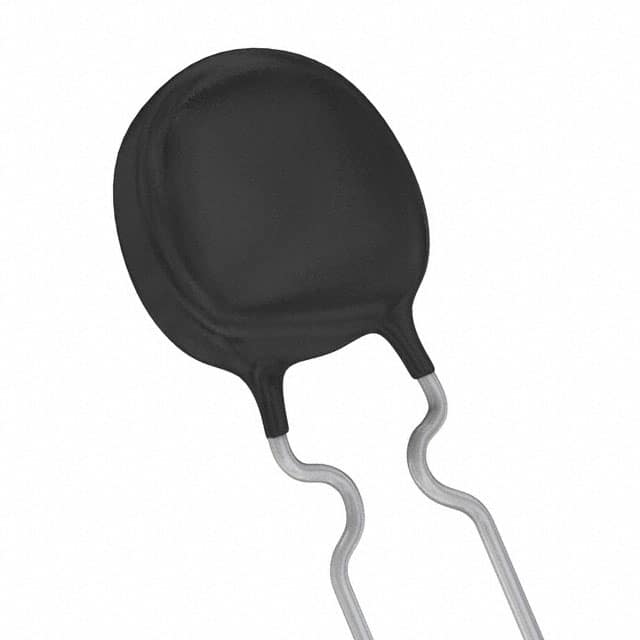Lihat spesifikasi untuk detail produk.

PTCCL17H601FBE Encyclopedia Entry
Product Overview
The PTCCL17H601FBE belongs to the category of Positive Temperature Coefficient (PTC) thermistors. These thermistors are commonly used for overcurrent protection, inrush current limiting, and temperature compensation in various electronic circuits. The PTCCL17H601FBE is characterized by its high reliability, precise temperature response, and compact package. It is typically available in tape and reel packaging with a specified quantity per reel.
Specifications
- Model: PTCCL17H601FBE
- Category: PTC Thermistor
- Resistance at 25°C: 60Ω
- Maximum Voltage: 24V
- Operating Temperature Range: -40°C to 125°C
- Package Type: SMD (Surface Mount Device)
- Packaging Quantity: 3000 pieces per reel
Detailed Pin Configuration
The PTCCL17H601FBE features a standard SMD pin configuration with two terminals for easy surface mounting on PCBs. The detailed pinout is as follows: 1. Pin 1: Positive Terminal 2. Pin 2: Negative Terminal
Functional Features
- Overcurrent Protection: The PTCCL17H601FBE exhibits a sharp increase in resistance when subjected to overcurrent conditions, effectively limiting the current flow.
- Inrush Current Limiting: It helps in reducing the inrush current during power-on situations, preventing damage to sensitive components.
- Temperature Compensation: The thermistor's resistance varies with temperature, making it suitable for temperature compensation applications.
Advantages and Disadvantages
Advantages
- High Reliability: Ensures consistent performance over a wide temperature range.
- Compact Size: Allows for space-efficient integration into electronic designs.
- Precise Temperature Response: Provides accurate temperature sensing and compensation.
Disadvantages
- Limited Voltage Handling: The maximum voltage rating may not be suitable for high-voltage applications.
- Non-linear Response: The resistance-temperature curve may exhibit non-linearity in certain operating ranges.
Working Principles
The PTCCL17H601FBE operates based on the positive temperature coefficient characteristic of PTC thermistors. As the temperature increases, the resistance of the thermistor also increases, leading to the functional features mentioned above.
Detailed Application Field Plans
The PTCCL17H601FBE finds extensive use in various electronic circuits and systems, including: - Power Supplies: Inrush current limiting for power supply units. - Motor Control: Overcurrent protection in motor control circuits. - Battery Management: Temperature compensation in battery charging circuits. - LED Lighting: Inrush current limitation for LED driver circuits.
Detailed and Complete Alternative Models
For users seeking alternative PTC thermistors, the following models can be considered: - PTCCL20H602FBE: Similar characteristics with a higher resistance value. - PTCCL15H600FBE: Lower resistance variant for specific applications. - PTCCL18H603FBE: Higher voltage handling capability with comparable temperature response.
In conclusion, the PTCCL17H601FBE offers reliable overcurrent protection, inrush current limiting, and temperature compensation in a compact SMD package, making it a versatile choice for various electronic applications.
[Word Count: 443]
Sebutkan 10 pertanyaan dan jawaban umum terkait penerapan PTCCL17H601FBE dalam solusi teknis
Sure, here are 10 common questions and answers related to the application of PTCCL17H601FBE in technical solutions:
What is PTCCL17H601FBE?
- PTCCL17H601FBE is a type of PTC thermistor, specifically designed for overcurrent protection in electronic circuits.
What is the operating voltage range of PTCCL17H601FBE?
- The operating voltage range of PTCCL17H601FBE is typically between 6V to 60V.
How does PTCCL17H601FBE provide overcurrent protection?
- PTCCL17H601FBE provides overcurrent protection by increasing its resistance when the current exceeds a certain threshold, effectively limiting the current flow.
What is the maximum current rating of PTCCL17H601FBE?
- The maximum current rating of PTCCL17H601FBE is typically around 1A to 3A.
Can PTCCL17H601FBE be used in automotive applications?
- Yes, PTCCL17H601FBE can be used in automotive applications for overcurrent protection in various electronic systems.
What are the typical applications of PTCCL17H601FBE?
- PTCCL17H601FBE is commonly used in power supplies, battery chargers, motor control circuits, and other electronic devices requiring overcurrent protection.
Does PTCCL17H601FBE require any external components for operation?
- No, PTCCL17H601FBE is a standalone overcurrent protection device and does not require additional external components for its operation.
What is the temperature range for PTCCL17H601FBE?
- The temperature range for PTCCL17H601FBE is typically between -40°C to 125°C, making it suitable for a wide range of operating environments.
Is PTCCL17H601FBE RoHS compliant?
- Yes, PTCCL17H601FBE is RoHS compliant, ensuring that it meets environmental standards for hazardous substances.
Can PTCCL17H601FBE be used in high-power applications?
- PTCCL17H601FBE is more suitable for low to moderate power applications due to its current and voltage ratings. For high-power applications, other PTC thermistors with higher ratings should be considered.

